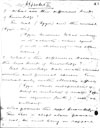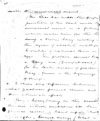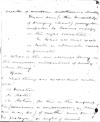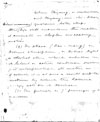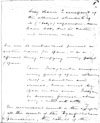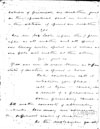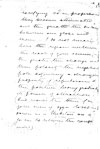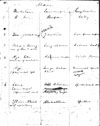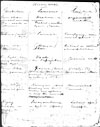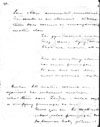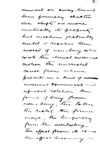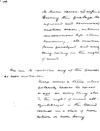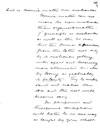Cosmological Notes: Difference between revisions
Pablo Sender (talk | contribs) No edit summary |
Pablo Sender (talk | contribs) No edit summary |
||
| Line 355: | Line 355: | ||
'''[[Fire (symbol)|Fire]], as everything else, has seven [[principle]]s. [[Odyle|Od]], one, but not the most material --- sixth.''' | '''[[Fire (symbol)|Fire]], as everything else, has seven [[principle]]s. [[Odyle|Od]], one, but not the most material --- sixth.''' | ||
(14) All [[Cosmic Matter|matter cosmic]] or organised has inherent [[motion]]. What then does Zhihna, vital soul or vivifying principle, do to it? | (14) All [[Cosmic Matter|matter cosmic]] or organised has inherent [[motion]]. What then does Zhihna, [[vital soul]] or vivifying principle, do to it? | ||
'''There you see. As well ask what [[Prāṇa|vital principle]] does for human body when it''' | '''There you see. As well ask what [[Prāṇa|vital principle]] does for human body when it''' | ||
| Line 371: | Line 371: | ||
{{Col-begin|width=98%}} | {{Col-begin|width=98%}} | ||
{{Col-break|width=55%}} | {{Col-break|width=55%}} | ||
'''comes into it in conjunction with the other five. A dead body is composed of molecules full of life, is it? Yet when [[ | '''comes into it in conjunction with the other five. A dead body is composed of molecules full of life, is it? Yet when [[vital soul]] has deserted the whole, what is it but a dead body. Give up your pansophy and come down to our [[Dzyu|Dgyu]]. We believe in spontaneous generation and you do not. We say that [[Vital soul|Zhima]] being positive, and [[Cosmic Matter|Zhi-gyu]] [gyu (material) earth in this sense] negative, it is only when the two come in contact as the former is brought to act upon the latter, that organised, living, self-acting [[matter]] is produced. Everything invisible, imponderable''' | ||
{{Col-break|width=3%}} | {{Col-break|width=3%}} | ||
{{Col-break|width=15%}} | {{Col-break|width=15%}} | ||
| Line 378: | Line 378: | ||
'''NOTES:''' | '''NOTES:''' | ||
* '''Zhima''' was spelled "Zhihna" | * '''Pansophy'''. In monotheistic belief systems it refers to God as being the ultimate knowing spirit. | ||
* '''Zhima''' was spelled "Zhihna" on the table. | |||
{{Col-end}} | {{Col-end}} | ||
| Line 455: | Line 456: | ||
{{Col-begin|width=98%}} | {{Col-begin|width=98%}} | ||
{{Col-break|width=55%}} | {{Col-break|width=55%}} | ||
'''You will never be able to realise the latter as an absurdity, so long as you comprehend but imperfectly the incessant work of what is called by [[Science#Occult_Science|Occult Science]] the [[Logos|Central Point]] in both its active and passive states. As I said, we believe in spontaneous generation, in the independent origin of [[matter]] whether living or dead, and we prove it, which is more than your Pasteurs and Wymans and Huxleys can say. Did they but know that [[Soul | '''You will never be able to realise the latter as an absurdity, so long as you comprehend but imperfectly the incessant work of what is called by [[Science#Occult_Science|Occult Science]] the [[Logos|Central Point]] in both its active and passive states. As I said, we believe in spontaneous generation, in the independent origin of [[matter]] whether living or dead, and we prove it, which is more than your Pasteurs and Wymans and Huxleys can say. Did they but know that [[Vital Soul|Zhima]] cannot be shut out or pumped out from a''' | ||
{{Col-break|width=3%}} | {{Col-break|width=3%}} | ||
{{Col-break|width=15%}} | {{Col-break|width=15%}} | ||
| Line 464: | Line 465: | ||
* '''Spontaneous generation'''. Aristotle thought that simple living things came forth spontaneously from the ''pneuma'', or "vital heat" present in nonliving things. | * '''Spontaneous generation'''. Aristotle thought that simple living things came forth spontaneously from the ''pneuma'', or "vital heat" present in nonliving things. | ||
* '''Louis Pasteur'''. His experiment is generally known to have refuted the theory of spontaneous generation in 1859. | * '''Louis Pasteur'''. His experiment is generally known to have refuted the theory of spontaneous generation in 1859. | ||
* '''Zhima''' was spelled "Zhihna" | * '''Zhima''' was spelled "Zhihna" on the table. | ||
{{Col-end}} | {{Col-end}} | ||
Revision as of 22:35, 31 October 2016
[ARTICLE UNDER CONSTRUCTION]
[ARTICLE UNDER CONSTRUCTION]

| Quick Facts | |
|---|---|
| People involved | |
| Written by: | Morya |
| Received by: | A. O. Hume |
| Sent via: | unknown |
| Dates | |
| Written on: | unknown |
| Received on: | Fall 1881??? |
| Other dates: | none |
| Places | |
| Sent from: | unknown |
| Received at: | ??? |
| Via: | none |
History
The Cosmological notes were written by Master M. in answer to questions put by A. O. Hume. They must have been received before September 1881 because they are mentioned by HPB in a letter to A. P. Sinnett written on that date (see LBS No. 4). In the chronology of Mahatma Letters, one could tentatively place these notes between letters No. 21 and 22. However, since letter No. 44 is the first one to deal exclusively with metaphysics, being actually a second set of cosmological teachings.
Fritz Kunz asked Boris de Zirkoff in a letter on the origin of the cosmological notes:
I know that you have a set of the microfilmed copy of the material in the British Museum catalogued under the heading of the "Mahatma Letters."
I wonder whether you would be so good as to advise me whether the pages entitled "Cosmological Notes" which are published near the very end of H.P.B.'s letter to A. P. Sinnett, are included therein, and if so, in whose handwriting, and whether you could kindly supply me with a sufficiently enlarged print of this so that I might have it at hand for my personal use? [1]
Boris de Zirkoff responded:
Re the "Mahatma Papers", Additional MS.45284, in the British Museum. Now the actual Letters, both those from the Masters and those from H.P.B. to Sinnett, have been bound up in separate volumes, seven in all. The originals of some of the Letters from the Masters, as transcribed in the published volume of Mahatma Letters, were not among the material bequeathed by Sinnett to Miss Maud Hoffman. They exist only as copies made by Sinnett in a separate leather-bound notebook. This notebook has been filmed also, when microfilm was prepared of the entire material. It is in this notebook that the "Cosmological Notes" are to be found; they are therefore in Sinnett's handwriting. There are 24 pages of this material.[2]
The text
Below are the Cosmological Notes from A. P. Sinnett's notebook (his MS. Book). In italics are the questions put by A. O. Hume and the bold type are the answers received from Master M. The images were scanned from Boris de Zirkoff's microfilm.
When A. P. Sinnett's sent a copy of this manuscript to Francesca Arundale he attached some notes. By the way of an introduction he wrote:
Notes from the Book of Kiu-te, the great repository of occult lore in the keeping of the Adepts in Tibet. I believe there are thirty or forty volumes, a great deal shown only to Initiates. What follows is merely some elementary catechism in the very beginning. We began to get these notes through Madame Blavatsky when Mr. Hume and I first set to work together . But we soon got off on to other lines of rail.
The very first thing I ever had in the way of philosophical teaching I sent you a copy of last year; it was sketch of the chain of worlds which I suppose you have somewhere still. Then we got in a fragmentary way the materials on which Hume wrote the first of the "Occult Fragments" --- that relating to the seven principles in man. It is necessary to have an absolute comprehension of that division at starting. It runs through all nature in various shapes and ways. I now copy out of my MS. Book. --- A.P. Sinnett.[3]
Additional comments by him will be provided below in the column for "Notes".
Page 1
|
(1) What are the different kinds of knowledge? The real (Dgyu) and the unreal (Dgyu-mi). Dgyu becomes Fohat when in its activity — active agent of will — electricity — no other name.
Real knowledge deals with eternal verities and primal causes. The unreal only with illusory effects. Dgyu stands independent of the belief or unbelief of man. Dgyu-mi requires faith — rests on authority.
The Lhas or adept alone possesses the real, his mind being en rapport |
NOTES: |
Page 2
|
with the Universal Mind. The Lhas has made the perfect junction of his soul with the Universal Mind in its fulness, which makes him for the time a divine being existing in the region of absolute intelligence, knowledge of natural laws or Dgyu. The profane cannot become a Dang-ma (purified soul), for he lacks means of perceiving Chhag, Genesis or the beginning of things.
None. Everything in the occult universe, which embraces all the primal causes, is based upon two principles — Kosmic energy (Fohat or |
NOTES: |
Page 3
|
breath of wisdom), and Kosmic ideation. Thyan Kam (= the knowledge of bringing about) giving the impulse to Kosmic energy in the right direction. In Fohat all that exists on earth as ultimates exists as primates.
(i) Duration. (ii) Matter. (iii) Motion, for this is the imperishable life (conscious or unconscious as the case may be) of matter, even during the pralaya, or night of mind. |
NOTES: |
Page 4
|
When Chyang or omniscience, and Chyang-mi-shi-khon — ignorance, both sleep, this latent unconscious life still maintains the matter it animates in sleepless unceasing motion. (iv) The Akasa (Bar-nang) or Kosmic atmosphere, or Astral light or celestial ether, which whether in its latent or active condition, surrounds and interpenetrates all matter in motion of which it is at once a result and the medium by which the Kosmic energy acts on its source. (v) The Purush or 7th principle of the universe. |
NOTES: |
Page 5
|
Ling Sharir is composed of the ethereal elements of its (? Body's) organism, never leaves body but at death and remains near.
Same. Swayambu occupies every part of space which itself is boundless and eternal, hence must be space in one sense. Swayambu becomes Purush when coming in contact with matter.
|
NOTES: |
Page 6
|
action of Purush on matter, just as the spiritual soul in man is the action of spirit on matter? Yes.
Yes, just so.
States, conditions, call it whatever you please. I call it Kyen — cause; itself a result of a previous or some primary cause.
As the molecules go on |
NOTES: |
Page 7
|
rarifying, so in proportion they become attenuated and the greater the distance between our globe and them — I do not mean here the region within the reach of your science — the greater the change in their polarity, the negative pole acquiring a stronger property of repulsion, and the positive losing gradually its power of attraction. (And now is the time for your men of Dgyu to set me down as a Thibetan ass, and for me to return the compliment.) |
NOTES: |
Page 8
|
(12) MAN
|
NOTES:
|
Page 9
|
(12) UNIVERSE
|
NOTES: |
Page 10
|
(13) Sem chan, animated universe: S.Sa, earth as an element. Where then does cosmic or unorganised matter class? Zhi gyu (cosmic matter), Thog (space), Nyng (duration), Khor wa (motion), all one. Fire, as everything else, has seven principles. Od, one, but not the most material --- sixth. (14) All matter cosmic or organised has inherent motion. What then does Zhihna, vital soul or vivifying principle, do to it? There you see. As well ask what vital principle does for human body when it |
NOTES: |
Page 11
|
comes into it in conjunction with the other five. A dead body is composed of molecules full of life, is it? Yet when vital soul has deserted the whole, what is it but a dead body. Give up your pansophy and come down to our Dgyu. We believe in spontaneous generation and you do not. We say that Zhima being positive, and Zhi-gyu [gyu (material) earth in this sense] negative, it is only when the two come in contact as the former is brought to act upon the latter, that organised, living, self-acting matter is produced. Everything invisible, imponderable |
NOTES:
|
Page 12
|
(the spirit of a thing) is positive, for it belongs to the world of reality; as everything solid, visible, is negative. Primate and ultimate, positive and negative. So much in our manifested world. As the forces move on and the distance between organised and unorganised matter becomes greater, a tendency towards the reverse begins to take place. The powers of attraction and repulsion become gradually weaker. Then a complete exchange of properties takes place, and for a time equilibrium is restored in an opposite order. At every grade further |
NOTES: |
Page 13
|
onward, or away toward their primary chaotic state, shifts no more mutually its property, but weakens gradually until it reaches the world of non-being, where exists the eternal mechanical motion, the uncreated cause from whence proceeds in a kind of incessant downward and upward rotation, the founts of being from non-being, the latter, the reality, the former maya, the temporary from the everlasting, the effect from its cause, the effect becoming in |
NOTES: |
Page 14
|
its turn cause ad infinitum. During the pralaya, that upward and downward motion ceases, inherent unconscious life alone remaining--all creative forces paralysed, and everything resting in the night of mind. (15) Are we to consider any of the principles as non-molecular? There comes a time when polarity ceases to exist or act, as everything else. In the night of mind, all is equilibrised in the boundless cosmos in a state of non-action or non-being. |
NOTES: |
Page 15
|
(16) And is cosmic matter non-molecular? Cosmic matter can no more be non-molecular than organised matter.--7th principle is molecular as well as the first one, but the former differentiates from the latter, not only by its molecules getting wider apart and becoming more attenuated, but also by losing its polarity. Try to understand and realise this idea and the rest will become easy. The panspermic and theospermic conceptions will both be in our way as taught by your schools. |
NOTES:
|
Page 16
|
You will never be able to realise the latter as an absurdity, so long as you comprehend but imperfectly the incessant work of what is called by Occult Science the Central Point in both its active and passive states. As I said, we believe in spontaneous generation, in the independent origin of matter whether living or dead, and we prove it, which is more than your Pasteurs and Wymans and Huxleys can say. Did they but know that Zhima cannot be shut out or pumped out from a |
[] |
NOTES:
|
Page 17
|
glass vessel like air, and that hence, wherever there is purush there can be no thermal limit of organic life, they would have bak-baked less and told the world less absurdities than they have. In short, motion, cosmic matter, duration, space, are everywhere and for perspicuity's sake, let us place or fancy this multiplicity in or at the top of a circle, ("boundless"). They are passive, negative, unconscious, yet ever propelled by their inherent latent life or force. During the day of activity, that cyclic |
[] |
NOTES: |
Page 18
|
force ejecting from the causative latent principle cosmic matter, like the wheel of a water mill ejects showers of water --- dust around its rotating circle, put it in contact with the same principles, but whose condition owing to their finding themselves outside the state of primitive passivity of the eternal immutability has already changed. Thus the same principles begin to acquire so to speak the germs of polarity. Then coming within the Universal mind Dyan Kam develops these germs, conceives, and giving the impulse |
[] |
NOTES: |
Page 19
|
communicates it to Fohat, who, vibrating along Akasa, Od (a state of cosmic matter, motion, force, etc.) runs along the lines of cosmic manifestations and frames all and everything; blindly --- agreed, yet as faithfully in accordance with the prototypes as conceived in the eternal mind as a good mirror reflects your face. (17) On the Hypothetical Absolute and Infinite Final Cause. The absolute and infinite is composed of the conditioned and finite. Causes are conditioned in their modes |
[] |
NOTES:
|
Page 20
|
of existence and attributes, and as individual aggregates -- unconditioned and eternal in their sum or as a collective aggregation. (18) If the Absolute is a blind law, how can it give birth to intelligence? But passive latent intelligence, or that principle diffused throughout the universe which in its pure immateriality is non-intelligence and non-consciousness, and which as soon as it becomes imprisoned in matter is transformed into both -- can. (19) The Absolute if intelligent, must be omnipotent, omniscient, and all-good? Please give your reasons why? |
[] |
NOTES: |
Page 21
|
Online resourcesArticles
Notes
|
